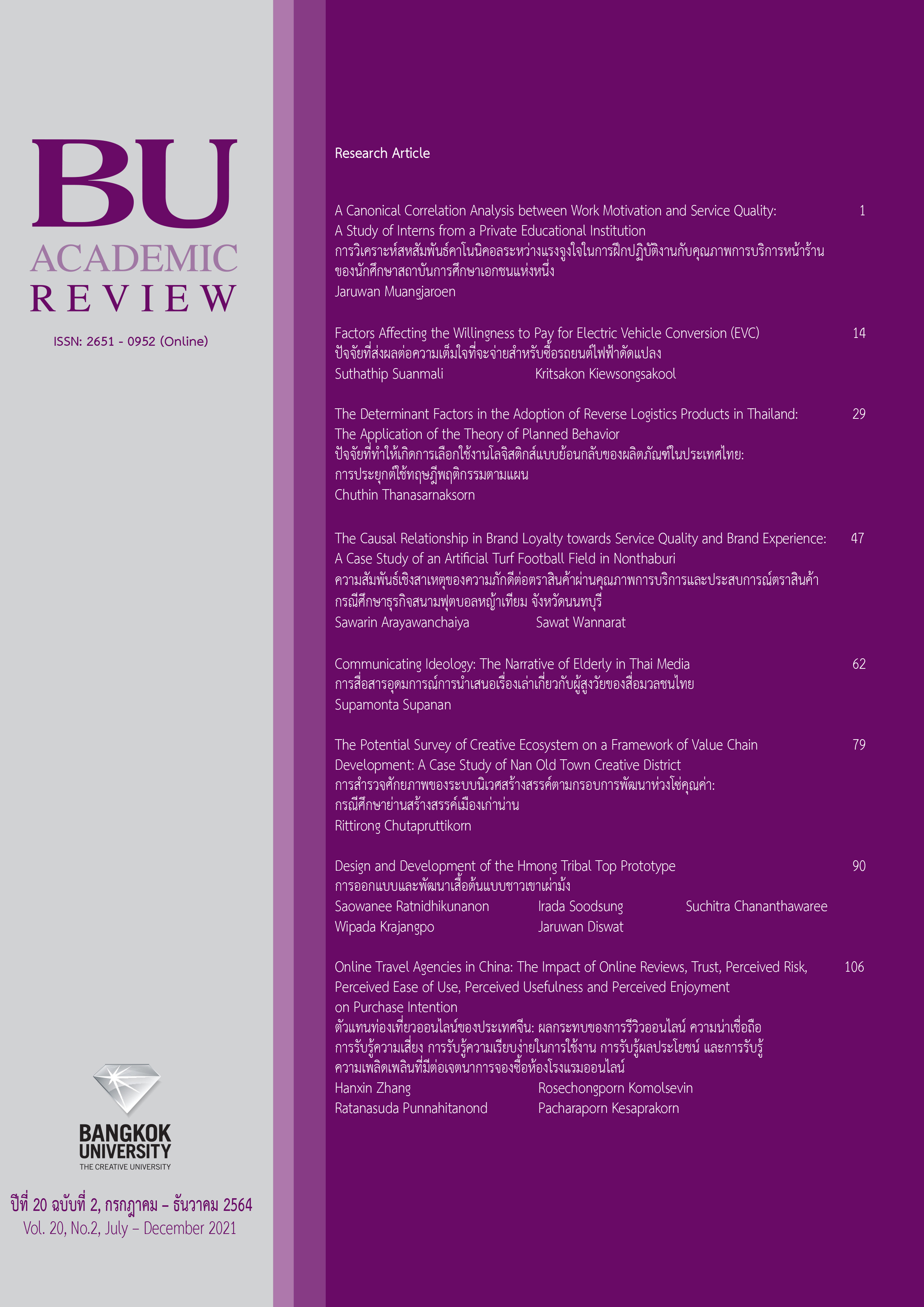A Canonical Correlation Analysis between Work Motivation and Service Quality: A Study of Interns from a Private Educational Institution
Main Article Content
Abstract
The research goals were to investigate the following: 1) the degree of intern motivation and student service quality in an educational institution, and 2) a canonical correlation analysis between intern motivation and student service quality in an educational institution. The study used quantitative technique with a sample size of 400 pupils. Questionnaires were used as a study tool and data were analyzed using percentage, standard deviation, and Pearson's Correlation, and Canonical Correlation Analysis were used to statistically examine the relationships between independent and dependent variables. The findings of this study revealed that the result of correlation value between intern motivation factor and service quality factor seems to perform a higher correlation.
Article Details
The manuscript submitted for publication must be the original version, submitted only to this particular journal with no prior acceptance for publication elsewhere in other academic journals. The manuscript must also not violate the copyright issue by means of plagiarism.
References
Bangmo, S. (2015). ʻOngkān læ kānčhatkān (Phim khrang thī 7) [Organization and management
(7th ed.)]. Bangkok: Wittayaphat.
Chai, S. C, Teoh, R. F., Razaob, N. A., & Kadar, M. (2017). Work motivation among occupational therapy graduates in Malaysia. Hong Kong Journal of Occupational Therapy, 30(1), 42-48.
Cronbach, J. L. (1990). Essentials of psychological testing (5th ed.). New York, NY: Harper and Row.
Domjan, M. P. (1996). The principles of learning and behavior. Belmont, CA: Thomson Wadsworth.
Herzberg, F. (1959). The motivation to work. New York: John Wiley & Sons.
Hinkle, D. E, William, W., & Stephen, G. J. (1998). Applied statistics for the behavior sciences (4th ed.). New York, NY: Houghton Mifflin.
Kinicki, A., Williams, B. K., Scott-Ladd, B. D., & Perry, M. (2011). Management: A practical introduction. North Ryde, NSW: McGraw-Hill Irwin.
Likert, R. (1961). New patterns of management. New York, NY: McGraw-Hill.
Lovell, R. B. (1980). Adult learning. New York: John Wiley & Son.
Manaschuen, T. (2017). Watthanatham ʻongkō̜n saphāpwǣtlō̜m nai ngān rǣng čhūngčhai nai ngān thī mī phon tō̜ khunnaphāp kān bō̜rikān læ khwām phakdī khō̜ng phanakngān phanǣk hō̜ng phak khō̜ng rōngrǣm nai khēt Krung Thēp Mahā Nakhō̜n [Organizational culture, working environment and motivation affecting service quality and room division personnel’s loyalty of hotels in Bangkok]. Journal of Thai Hospitality & Tourism, 12(2), 57-70.
Panda, T. K. (2013). Effects of service quality and salesperson characteristics on consumer trust and relationship commitment: An empirical study on insurance buyers in India. Vision: The
Journal of Business Perspective, 17(4), 285-292.
Panyapiwat Institute of Management. (2019). Sathāban ʻudomsưksā dōi sī phī ʻō̜n. [Institution of education by CP all]. Retrieved May 24, 2019, from https://www.pim.ac.th/en/pages/cpall.
Rovinelli, R. J., & Hambleton, R. K. (1977). On the use of content specialists in the assessment of criterion-referenced test item validity. Dutch Journal of Educational Research, 2, 49-60.
Tabachnick, B. G., & Fidell, L. S. (2007). Using multivariate statistics (5th ed.). Boston, MA: Pearson.
Vetrakova, M., & Mazúchová, L. (2015). Modeling of process work motivation in hotels. Procedia Economics and Finance, 34, 508-513.
Vroom, V. H. (1970). Work and motivation. New York: John Willey & Son.
Yamane, T. (1967). Statistics: An introductory analysis. New York: Harper and Row.
Yoder, D. (1958). Personnel principles and policies. New Jersey: Prentice Hall, Inc.
Ziethaml, V. A., Parasuraman A., & Berry, L. L. (1990). Delivering quality service: Balancing customer perceptions and expectations. New York: The Free Press.


